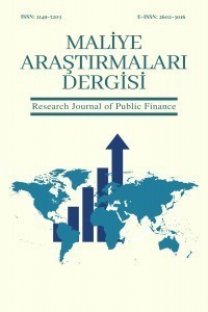Impact of Public Expenditures and Economic Classification on Growth: Turkey Analysis
Public Expenditures, EconomicClassification, VAR Method
Impact of Public Expenditures and Economic Classification on Growth: Turkey Analysis
Public Expenditures, EconomicClassification, VAR Method,
___
Ağayev, S. (2012), “Kamu Harcamaları ve Ekonomik Büyüme İlişkisi: Eski Sovyetler Birliği Ülkelerinde Wagner Yasası Analizi (1995-2009)”, Eskişehir Osmangazi Üniversitesi, İİBF Dergisi, Sayı: 7(2), p. 7-27.Alexiou, C. (2009), “Goverment Spending and Economic Growth: Econometric Evidence from The South Eastern Europe”, Journal of Economic and Social Research, Vol: 11(1), p. 1- 16.
Altunç, Ö. F. (2011), “Kamu Harcamaları ve Ekonomik Büyüme İlişkisi: Türkiye’ye İlişkin Ampirik Kanıtlar”, Yönetim ve Ekonomi, Vol: 18(2), p. 144-157.
Arpaia, A. and Turrini A. (2008), “Governmenet Expenditure and Economic Growth in the EU: Long-Run Tendencies and Short-Term Adjustment”, Economic and Financial Affairs, Economic Papers 300, February, p. 1-52.
Bağdigen, M. and Beşer B. (2009), “Ekonomik Büyüme İle Kamu Harcamaları Arasındaki Nedensellik İlişkisinin Wagner Tezi Kapsamında Bir Analizi: Türkiye Örneği”, ZKÜ Sosyal Bilimler Dergisi, Vol: 5(9), p. 1-17.
Barışık, S. and Kesikoğlu F. (2006), “Türkiye'de Bütçe Açıklarının Temel Makro Ekonomik Değişkenler Üzerine Etkisi (1987-2003 VAR, Etki-Tepki Analizi, Varyans Ayrıştırması)”, Ankara Üniversitesi SBF Dergisi, Vol: 61(4), p. 59-82.
Barro, R. J. (1991), “Economic Growth in a Cross-Section of Countries”, NBER Working Paper Series, No: 3120, http://www.nber.org/papers/w3120.pdf (Accessed: 4.12.2016).
Başar, S., Aksu H., Temurlenk S. M. and Polat Ö. (2009), “Türkiye’de Kamu Harcamaları ve Büyüme İlişkisi: Sınır Testi Yaklaşımı”, Atatürk Üniversitesi, Sosyal Bilimler Enstitüsü Dergisi, Vol: 13(1), p. 301-314.
Devaragan, S., Swaroop V. and Zou H. (1996), “The Composition of Public Expenditure and Economic Growth”, Journal of Monetary Economics, Vol: 37, p. 313-344.
Gangal, V. L. N. and Gupta H. (2013), “Public Expenditure and Economic Growth A Case Study of India”, Global Journal of Management and Business Studies, Vol: 3(2), p. 191-196.
Gül, E. and Yavuz H. (2011), “Türkiye’de Kamu Harcamaları İle Ekonomik Büyüme Arasındaki Nedensellik İlişkisi: 1963-2008 Dönemi”, Maliye Dergisi, Vol: 160, p. 72-85.
Ilgın, Y. (2003), “Kamu Sabit Sermaye Yatırım Stratejileri ve 2002 Yılında Kamu Proje Stoku”, Planlama Dergisi, p. 361-376.
Kanca, O. C. (2011), “Kamu Harcamalarının Ekonomik Büyüme Üzerine Etkisi 1980-2008 (Ampirik Bir Çalışma)”, Atatürk Üniversitesi, İktisadi ve İdari Bilimler Dergisi, Vol: 25(1), p. 75-92.
Kar, M. and Taban S. (2003), Kamu Harcama Çeşitlerinin Ekonomik Büyüme Üzerine Etkileri, Ankara Üniversitesi SBF Dergisi, Sayı: 58-3, ss. 145-169.
Kara, O., Çömlekçi İ. and Kaya V. (2012), “Turizm Gelirlerinin Çeşitli Makroekonomik Göstergeler İle İlişkisi: Türkiye Örneği (1992-2011)”, Ekonomik ve Sosyal Araştırmalar Dergisi, Vol: 8(1), p. 75-100.
Nurudeen, A. and Usman A. (2010), “Government Expenditure And Economic Growth in Nigeria, 1970-2008: A Disaggregated Analysis”, Business and Economics Journal, BEJ-4, 1-11, 004.pdf (Accessed: 1.12.2016).
Oktayer, N. and Susam N. (2008), “Kamu Harcamaları-Ekonomik Büyüme İlişkisi: 1970-2005 Yılları Türkiye Örneği”, Atatürk Üniversitesi, İktisadi ve İdari Bilimler Dergisi, Vol: 22(1), p. 145-164.
Ramey, V. A. (2009), “Identifying Government Spending Shocks: It’s All in the Timing”, National Bureau of Economic Research, Working No:15464.
Rose, N., Haque, M. E. and Osborn D. R. (2007), “Public Expenditure and Economic Growth: A Disaggregated Analysis for Developing Countries”, The Manchester School, Vol: 75(5), p. 533-556.
Susam, N. (2009), Türkiye’de Uygulanan Maliye Politikaları 1923-2008, Derin Yayınları, No: 156.
Tanzi, V. and Schuknecht L. (2000), Public Spending in the 20th Century: a Global Perspective, Cambridge University Press.
Tuna, K. (2013), “Türkiye’de Wagner Kanunu’nun Geçerliliğinin Test Edilmesi”, İşletme ve İktisat Çalışmaları Dergisi, Vol: 1(3), p. 54-57.
Uzay, N. (2002), “Kamu Büyüklüğü ve Ekonomik Büyüme Üzerindeki Etkileri: Türkiye Örneği (1970-1999)”, Erciyes Üniversitesi İ.İ.B.F. Dergisi, Vol: 19, p. 151-172.
Yıldız, F. and Sarısoy S. (2012), “OECD Ülkelerinde Kamu Harcamaları ve Ekonomik Büyüme İlişkisi Üzerine Ampirik Bir Çalışma”, Marmara Üniversitesi İİBF Dergisi, Vol: 33(2), p. 517-540.
Yüksel, C. and Songur M. (2011), “Kamu Harcamalarının Bileşenleri ile Ekonomik Büyüme Arasındaki İlişki: Ampirik Bir Analiz (1980-2010)”, Maliye Dergisi, Vol: 161, p. 365- 380.
- ISSN: 2149-5203
- Yayın Aralığı: Yılda 2 Sayı
- Başlangıç: 2015
- Yayıncı: PESA
Kamu Borç Yönetiminin Maliye ve Para Politikası ile Uyum Sorunu: Türkiye Pratiği
Türkiye’de Savunma Eğitim ve Sağlık Harcamaları Arasındaki İlişki Hakkında Ampirik Bir İnceleme
Rasyonaliteden İrrasyonaliteye: Davranışsal İktisat Yaklaşımı ve Bilişsel Önyargılar
Impact of Public Expenditures and Economic Classification on Growth: Turkey Analysis
Mehmet Hanefi TOPAL, Hamdi Furkan GÜNAY
Türkiye’de Gelir Dağılımına Etki Eden Faktörlerin En Küçük Kareler Yöntemi ile Analizi
Abdullah Miraç BÜKEY, Başak Işıl ÇETİN
Küresel Finansal Krizin BRIC Ülkeleri Üzerindeki Makro Ekonomik Etkileri
